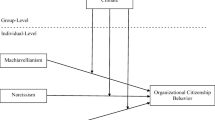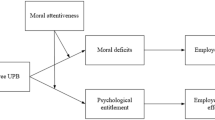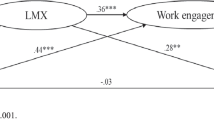Abstract
This study examines two competing theories. Self-enhancement theory predicts that self-esteem and equity sensitivity (narrow traits) increase the perception of psychological contract breach and engage less in organizational citizenship behavior (OCB), whereas self-consistency theory predicts that these two traits attenuate the perception of psychological contract breach and engage more in OCB. Agreeableness and Conscientiousness (broad traits) are expected to moderate the mediation. This study employs moderated mediation analysis to test a sample of 204 supervisor–subordinate dyads from two theme parks in northern and central Taiwan. The results show that employees high in self-esteem are less likely to perceive psychological contract breach and engage more in OCB, confirming self-consistency theory. The results also show that this mediation is observed when Agreeableness and Conscientiousness are higher than when they are lower. Theoretical and practical implications are discussed.



Similar content being viewed by others
References
Adams, G. L., Treadway, D. C., & Stepina, L. P. 2008. The role of dispositions in politics perception formation: The predictive capacity of negative and positive affectivity, equity sensitivity, and self-efficacy. Journal of Managerial Issues, 10(4): 545–563.
Adams, J. S. 1965. Inequity in social exchange. In L. Berkowitz (Ed.). Advances in experimental social psychology: 267–299. New York: Academic.
Ahadi, S. A., & Rothbart, M. K. 1994. Temperament, development, and the big five. In C. F. Halverson, G. A. Kohnstamm, & R. P. Martin (Eds.). The developing structure of temperament and personality from infancy to adulthood: 189–207. Hillsdale, NJ: Erlbaum.
Aiken, L. S., & West, S. G. 1991. Multiple regression: Testing and interpreting interactions. Newbury Park, CA: Sage.
Ashford, S. J., & Tsui, A. S. 1991. Self-regulation for managerial effectiveness: The role of active feedback seeking. Academy of Management Journal, 34(2): 251–280.
Barrick, M. R., & Mount, M. K. 1991. The big five personality dimensions and job performance: A meta-analysis. Personnel Psychology, 44(1): 1–26.
Barrick, M. R., Mount, M. K., & Straus, J. P. 1993. Conscientiousness and performance of sales representatives: Test of the mediating effects of goal setting. Journal of Applied Psychology, 78(5): 715–722.
Blaine, B., & Crocker, J. 1993. Self-esteem and self-serving biases in reactions to positive and negative events: An integrative review. In R. F. Baumeister (Ed.). Self-esteem: The puzzle of low self-regard: 55–85. New York: Plenum.
Bliese, P. D. 2000. Within-group agreement, non-independence, and reliability: Implications for data aggregation and analysis. In K. J. Klein & S. W. J. Kozlowski (Eds.). Multilevel theory, research, and methods in organizations: Foundations, extensions, and new directions: 349–381. San Francisco, CA: Jossey-Bass.
Bradley, G. W. 1978. Self-serving biases in the attribution process: A reexamination of the fact or fiction question. Journal of Personality and Social Psychology, 36(1): 56–71.
Brislin, R. W. 1970. Back-translation for cross-cultural research. Journal of Cross-Cultural Psychology, 1(3): 185–216.
Brockner, J. 1988. Self-esteem at work: Research, theory, and practice. Lexington, MA: Lexington Books.
Brutus, S., Ruderman, M. N., Ohlott, P. J., & McCauley, C. D. 2000. Developing from job experiences: The role of organization-based self-esteem. Human Resource Development Quarterly, 11(4): 367–380.
Carver, C. S., & Scheier, M. F. 1981. Attention and self-regulation: A control-theory approach to human behavior. New York: Springer.
Chen, Y., Friedman, R., Yu, E., & Sun, F. 2011. Examining the positive and negative effects of guanxi practice: A multi-level analysis of guanxi practices and procedural justice perceptions. Asia Pacific Journal of Management, 28(4): 715–735.
Colquitt, J. A., & Zapata-Phelan, C. 2007. Trends in theory building and theory testing: A five-decade study of the academy of management journal. Academy of Management Journal, 50(6): 1281–1303.
Costa, P. T., Jr., & McCrae, R. R. 1998. Traits theory of personality. In D. F. Barone, M. Hersen & V. B. V. Hasselt (Eds.). Advanced personality, the plenum series in social/clinical psychology: 103–1021. New York: Plenum Press.
Coyle-Shapiro, J., & Kessler, I. 2000. Consequences of the psychological contract for the employment relationship: A large scale survey. Journal of Management Studies, 37(7): 903–930.
De Vos, A., & Meganck, A. 2009. What HR managers do versus what employees value: Exploring both parties’ views on retention management from a psychological contract perspective. Personnel Review, 38(1): 45–60.
DeVellis, R. F. 1991. Scale development. Newbury Park, NJ: Sage.
Dyne, L. V., & Ang, S. 1998. Organizational citizenship behavior of contingent worker in Singapore. Academy of Management Journal, 41(6): 692–703.
Gecas, V. 1982. The self-concept. Annual Review of Sociology, 8: 1–33.
Gecas, V., & Schwalbe, M. L. 1983. Beyond the looking-glass self: Social structure and efficacy-based self-esteem. Social Psychology Quarterly, 46(2): 77–88.
Goldberg, L. R. 1990. An alternative “description of personality”: the big five factor structure. Journal of Personality and Social Psychology, 59(6): 1216–1229.
Goldberg, L. R. 1992. The development of markers for the big-five factor structure. Psychological Assessment, 4(1): 26–42.
Graziano, W. G., Jensen-Campbell, L. A., & Hair, E. C. 1996. Perceiving interpersonal conflict and reacting to it: The case for agreeableness. Journal of Personality and Social Psychology, 70(4): 820–835.
Graziano, W. G., & Tobin, R. M. 2002. Agreeableness: Dimension of personality or social desirability artifact?. Journal of Personality, 70(5): 695–728.
Ho, V. T., Weingart, L. R., & Rousseau, D. M. 2004. Responses to broken promises: Does personality matter?. Journal of Vocational Behavior, 65(2): 276–293.
Hoyle, R. H., & Kenny, D. A. 1999. Statistical power and tests of mediation. In R. H. Hoyle (Ed.). Statistical strategies for small sample research. Newbury Park, CA: Sage.
Hui, C., Lee, C., & Rousseau, D. M. 2004. Psychological contract and organizational citizenship behavior in China: Investigating generalizability and instrumentality. Journal of Applied Psychology, 89(2): 311–321.
Huseman, R. C., Hatfield, J. D., & Mile, E. W. 1985. Test for individual perceptions of job equity: Some preliminary findings. Perceptual and Motor Skills, 61(3): 1055–1064.
Huseman, R. C., Hatfield, J. D., & Miles, E. W. 1987. A new perspective on equity theory: The equity sensitivity construct. Academy of Management Review, 12(2): 222–234.
Jensen-Campbell, L. A., & Graziano, W. G. 2001. Agreeableness as a moderator of interpersonal conflict. Journal of Personality, 69(2): 323–362.
Jensen-Campbell, L. A., Rosselli, M., Workman, K. A., Santisi, M., Rios, J. D., & Bojan, D. 2002. Agreeableness, conscientiousness, and effortful control processes. Journal of Research in Personality, 36(5): 476–489.
John, O. P. 1990. The big five factor taxonomy: Dimensions of personality in the natural language and in questionnaires. In L. A. Pervin (Ed.). Handbook of personality: Theory and research: 66–100. New York: Guilford.
Jones, S. C. 1973. Self and interpersonal evaluations: Esteem theories versus consistency theories. Psychological Bulletin, 79(3): 185–199.
Judge, T. A., Locke, E. A., & Durham, C. C. 1997. The dispositional cause of job satisfaction: A core evaluations approach. Research in Organizational Behavior, 19: 151–188.
Kenny, D. A., & Judd, C. M. 1986. Consequences of violating the independence assumption in analysis of variance. Psychological Bulletin, 99(3): 422–431.
Kickul, J., & Lester, S. W. 2001. Broken promises: Equity sensitivity as a moderator between psychological contract breach and employee attitudes and behavior. Journal of Business and Psychology, 16(2): 191–217.
King, W. C., & Miles, E. W. 1994. The measurement of equity sensitivity. Journal of Occupational and Organizational Psychology, 67(2): 133–142.
King, W. C., Miles, E. W., & Day, D. D. 1993. A test and refinement of the equity sensitivity. Journal of Organizational Behavior, 14(4): 301–317.
Koch, B. J., & Koch, P. 2007. Collectivism, individualism, and outgroup cooperation in a segmented China. Asia Pacific Journal of Management, 24(2): 207–225.
Korman, A. K. 1976. Hypothesis of work behavior revisited and an extension. Academy of Management Review, 1(1): 50–63.
Lambert, S. J. 2000. Added benefits: The link between work-life benefits and organizational citizenship behavior. Academy of Management Journal, 43(5): 801–815.
Liguori, E. W., Taylor, S. G., Kluemper, D. H., & Sauley, K. S. 2011. Testing measures of equity sensitivity for resistance to response distortion. Journal of Managerial Issues, 13(1): 46–61.
MacKinnon, D. P., Lockwood, C. M., Hoffman, J. M., West, S. G., & Sheets, V. 2002. A comparison of methods to test mediation and other intervening variable effects. Psychological Methods, 7(1): 83–104.
McCrae, R. R., & Costa, P. T. 1987. Validation of a five-factor model of personality across instruments and observers. Journal of Personality and Social Psychology, 52(1): 81–90.
McFarlin, D. B., & Blascovich, J. 1981. Effects of self-esteem and performance feedback on future affective preferences and cognitive expectations. Journal of Personality and Social Psychology, 40(3): 521–531.
Miles, E. W., Hatfield, J. D., & Huseman, R. C. 1994. Equity sensitivity and outcome importance. Journal of Organizational Behavior, 15(7): 585–596.
Miles, E. W., Hatfield, J. D., & Huseman, R. C. 1989. The equity sensitivity construct: Potential implications for worker performance. Journal of Management, 15(4): 581–588.
Miller, D. T., & Ross, M. 1975. Self-serving biases in the attribution of causality: Fact or fiction?. Psychological Bulletin, 82(2): 231–225.
Morrison, E. W., & Robinson, S. L. 1997. When employees feel betrayed: A model of how psychological contract violation develops. Academy of Management Review, 22(1): 226–256.
Moy, J. W., & Lam, K. F. 2004. Selection criteria and the impact of personality on getting hired. Personnel Review, 33(5): 521–535.
Nikolaou, I., Tomprou, M., & Vakola, M. 2007. Individuals’ inducements and the role of personality: Implications for psychological contracts. Journal of Managerial Psychology, 22(7): 649–663.
Northcraft, G. B., & Ashford, S. J. 1990. The preservation of self in everyday life: The effects of performance expectations and feedback context on feedback inquiry. Organizational Behavior and Human Decision Processes, 47(1): 42–64.
Nunnally, J. C. 1978. Psychometric theory. New York: McGraw-Hill.
Oh, I.-S., Wang, G., & Mount, M. K. 2011. Validity of observer ratings of the five-factor model of personality traits: A meta-analysis. Journal of Applied Psychology, 96(4): 762–773.
Pierce, J. L., Gardner, D. G., Cummings, L. L., & Dunham, R. B. 1989. Organization-based self-esteem: Construct definition, measurement, and validation. Academy of Management Journal, 32(3): 622–648.
Podsakoff, P. M., MacKenzie, S. B., Lee, J. Y., & Podsakoff, N. P. 2003. Common method biases in behavior research: A critical review of the literature and recommended remedies. Journal of Applied Psychology, 88(5): 879–903.
Podsakoff, P. M., & Organ, D. W. 1986. Self-reports in organizational research: Problems and prospects. Journal of Management, 12(4): 531–544.
Preacher, K. J., & Hayes, A. F. 2004. SPSS and SAS procedures for estimating indirect effects in simple mediation models. Behavior Research Methods, Instruments, & Computers, 36(4): 717–731.
Preacher, K. J., Rucker, D. D., & Hayes, A. F. 2007. Addressing moderated mediation hypotheses: Theory, methods, and prescriptions. Multivariate Behavioral Research, 42(1): 185–227.
Raja, U., Johns, G., & Ntalianis, F. 2004. The impact of personality on psychological contracts. Academy of Management Journal, 47(3): 350–367.
Restubog, S. L. D., Bordia, P., & Bordia, S. 2009. The interactive effects of procedural justice and equity sensitivity in predicting responses to psychological contract breach: An interactionist perspective. Journal of Business and Psychology, 24(2): 165–178.
Restubog, S. L. D., Bordia, P., & Tang, R. L. 2007. Behavioural outcomes of psychological contract breach in a non-western culture: The moderating role of equity sensitivity. British Journal of Management, 18(4): 376–386.
Robinson, D., & Smith-Lovin, L. 1992. Selective interaction as a strategy for identity maintenance and affect control model. Social Psychology Quarterly, 55(1): 12–28.
Robinson, S. L. 1996. Trust and breach of the psychological contract. Administrative Science Quarterly, 41(4): 574–599.
Robinson, S. L., & Morrison, E. W. 1995. Psychological contracts and OCB: The effect of unfulfilled obligations on civic virtue behavior. Journal of Organizational Behavior, 16(3): 289–298.
Rosenberg, M., Schooler, C., Schoenback, C., & Rosenberg, F. 1995. Global self-esteem and specific self-esteem. American Sociological Review, 60(1): 141–156.
Rousseau, D. M. 1989. Psychological can implied contracts in organizations. Employee Responsibilities and Rights Journal, 2(2): 121–139.
Rousseau, D. M. 1990. New hire perceptions of their own and their employer’s obligations: A study of psychological contracts. Journal of Organizational Behavior, 11(5): 389–400.
Rousseau, D. M. 1995. Psychological contracts in organizations: Understanding written and unwritten agreements. Thousand Oaks, CA: Sage.
Rousseau, D. M., & Tijoriwala, S. A. 1998. Assessing psychological contracts: Issues, alternatives and types of measures. Journal of Organizational Behavior, 19(1): 679–696.
Saucier, G. 1994. Mini-markers: A brief version of Goldberg’s unipolar big-five markers. Journal of Personality Assessment, 63(3): 506–516.
Schmitt, N. 1994. Method bias: The importance to theory and measurement. Journal of Organizational Behavior, 15(5): 393–398.
Shih, C. T., & Chen, S. J. 2011. The social dilemma perspective on psychological contract fulfillment and organizational citizenship behavior. Management and Organization Review, 7(1): 125–151.
Shoda, Y., & Mischel, W. 1993. Cognitive social approach to dispositional inferences: What if the perceiver is a cognitive social theorist?. Personality and Social Psychology Bulletin, 19(5): 547–586.
Shrout, P. E., & Bolger, N. 2002. Mediation in experimental and nonexperimental studies: New procedures and recommendations. Psychological Methods, 7(4): 422–445.
Skarlicki, D. P., Folger, R., & Tesluk, P. 1999. Personality as a moderator in the relationship between fairness and retaliation. Academy of Management Journal, 42(1): 100–108.
Snyder, M. L., Stephan, W. G., & Rosenfield, D. 1978. Egotism and attribution. In J. H. Harvey Wickes & R. F. Kidd (Eds.). New directions in attribution research: 91–120. Hillsdale, NJ: Erlbaum.
Sobel, M. E. 1982. Asymptotic confidence intervals for indirect effects in structural equations models. In S. Leinhart (Ed.). Sociological methodology: 290–312. San Francisco, CA: Jossey-Bass.
Swann, W. B. 1983. Self-verification: Bringing social reality into harmony with the self. In J. Suls & A. G. Greenwald (Eds.). Social psychological perspectives on the self: 33–66. Hillsdale, NJ: Erlbaum.
Swann, W. B., & Read, S. J. 1981. Self-verification processes: How we sustain our self-conceptions. Journal of Experimental Social Psychology, 17(4): 351–372.
Tang, T., & Sarsfield-Baldwin, L. 1990. The effects of self-esteem, task label, and performance feedback on goal setting, certainty, and attribution. Journal of Psychology, 125: 413–418.
Taylor, S. E., & Brown, J. D. 1988. Illusion and well-being: A social psychological perspective on mental health. Psychological Bulletin, 103(2): 193–210.
Tobin, R. M., Graziano, W. G., Vanman, E. J., & Tassinary, L. G. 2000. Personality, emotional experience, and efforts to control emotions. Journal of Personality and Social Psychology, 79(4): 656–669.
Turnley, W. H., & Feldman, D. C. 1998. Psychological contract violations during corporate restructuring. Human Resource Management, 37(1): 71–83.
Vasta, R., & Brockner, J. 1979. Self-esteem and self-evaluation covert statement. Journal of Consulting and Clinical Psychology, 47(6): 776–777.
Vohs, K. D., & Baumeister, R. F. 2004. Understanding self-regulation. In R. F. Baumeister & K. D. Vohs (Eds.). Handbook of self-regulation: 1–9. New York: Guilford.
White, S. 2002. Rigor and relevance in Asian management research: Where are we and where can we go?. Asia Pacific Journal of Management, 19(2–3): 287–352.
Williams, L. J., & Anderson, S. E. 1991. Job satisfaction and organizational commitment as predictors of organizational citizenship and in-role behaviors. Journal of Management, 17(3): 601–617.
Zhao, H., Wayne, S. J., & Glibkowski, B. C. 2007. The impact of psychological contract breach on work-related outcomes: A meta-analysis. Personnel Psychology, 60(3): 647–680.
Zhong, J. A., Lam, W., & Chen, Z. 2011. Relationship between leader–member exchange and organizational citizenship behaviors: Examining the moderating role of empowerment. Asia Pacific Journal of Management, 28(3): 609–626.
Author information
Authors and Affiliations
Corresponding author
Additional information
The authors thank the APJM senior editor (Chi-Sum Wong) and two anonymous reviewers for their valuable comments. An earlier version of this article was presented as an interactive paper at the 2009 Academy of Management annual meeting, Chicago, Illinois, August 2009. This research was supported by Taiwan’s National Science Council Research Fund (NSC 95-2416-H-366-001).
Rights and permissions
About this article
Cite this article
Shih, CT., Chuang, CH. Individual differences, psychological contract breach, and organizational citizenship behavior: A moderated mediation study. Asia Pac J Manag 30, 191–210 (2013). https://doi.org/10.1007/s10490-012-9294-8
Published:
Issue Date:
DOI: https://doi.org/10.1007/s10490-012-9294-8




